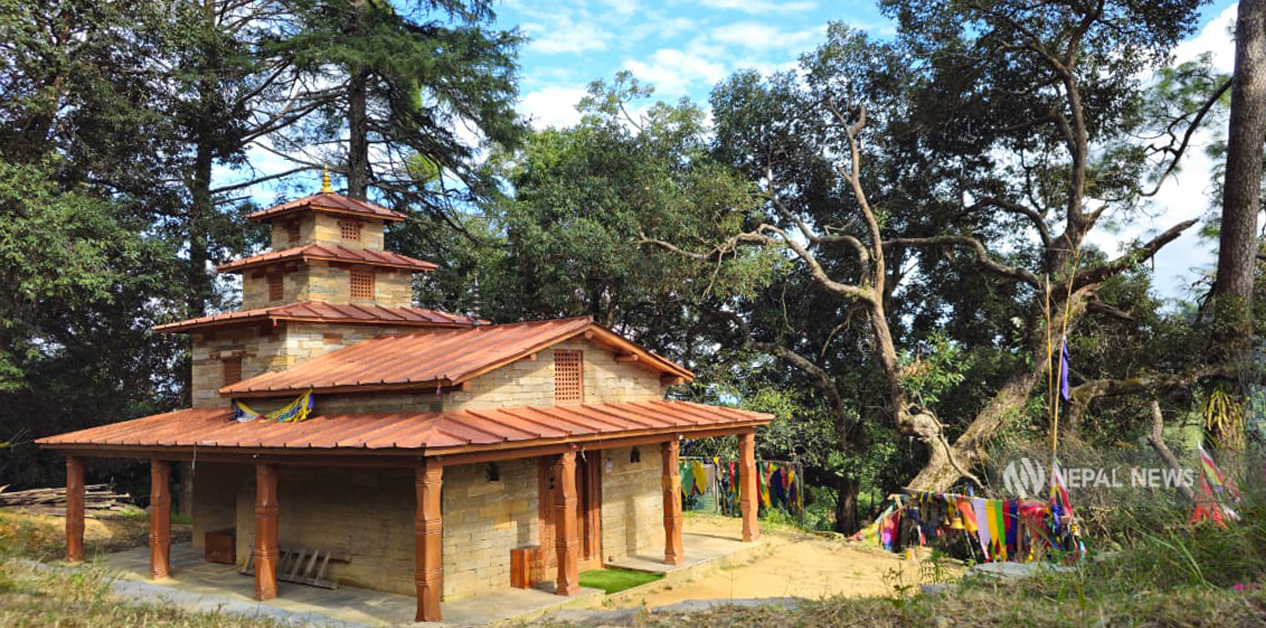
The tradition of worshipping shrines in the Far-Western hills before receiving tika on Bijaya Dashami

Dashain in the hills of the Far-West begins with planting jamara at temples and household shrines. The true feeling of Dashain in this region is sensed when, on the day of Phulpati, a troop of the Nepal Army marches with fanfare to the Tundikhel of Amargadhi, near Dadeldhura.
This Tundikhel, only a five-minute walk from the historic Amargadhi fort, is where Gorkhali soldiers once performed their drills. From here, two hundred years ago, Amar Singh Thapa launched his victorious campaign across the Kali River up to Kangra.
Near Khalanga, considered the headquarters during Thapa’s time, lies the famous shrine of Ugratara Temple. Here, people first receive the black tika (tilak) offered after worshipping the goddess, only then do they go home on Dashain day to receive the traditional red tika from their elders.
Except for the main day of Bijaya Dashami—which is reserved for family worship—people are free during the other four days to travel and exchange tika with relatives.
On Maha Ashtami, processions carrying musical bands and flags arrive at Ugratara Temple from the four neighboring villages of Damada, Khanmada, Jiloda, and Chachoda to honor the goddess.
All the items and symbols of the deity used in the procession are kept inside the goddess’s court on Ashtami and Navami. On Dashain day, after worshipping the goddess, the procession is returned in the same manner to the respective village deity shrines, after which people go home to receive tika.
In most villages of Dadeldhura, locals cut jamara that had been planted on Ghatasthapana at their ancestral deity’s temple, first offering it to the gods before wearing it as tika. A portion of this jamara is then taken home and mixed with the household jamara for tika.
Another famous religious site here is the Ghatalsthan Temple, where worship is offered to Ghatotkacha, son of Hidimba, who is considered a deity of the Kali Yuga. In the nearby village of Asigram, however, the custom is to eat and celebrate after receiving tika at home, and only then visit the fair held on Dashain day.
In the hill districts of the Far-West, Bijaya Dashami is in a sense celebrated as “the gods’ Dashain.” The heads of households fast until they have received tika from the deities.
From Achham’s Baidyanath to Darchula’s Malikarjun, from Baitadi’s Tripura Sundari to Doti’s Shaileshwari, the Shakti shrines and sacred places of every district are worshipped before anything else on Dashain. People pour out their grief before the gods. They ask forgiveness for their mistakes. They seek ways for peace in life. Their hearts are lightened.
Through the shamans appointed by the gods, time is set for fulfilling requests. Solutions are prescribed. Those who have committed wrongs are also given orders of penalty or fine.
In many temples, this period sees a two-way dialogue between gods and humans, almost like a courtroom. Obeying the gods’ commands in these religious assemblies carries the weight of social obligation. Those whose past wishes have been fulfilled make offerings on this very day—bells, swords, tridents, sal tree pillars, bugles, copper and brass figures of tigers and serpents, as well as cloth, flags, and even gold and silver.
Both those who ask and those whose requests are granted also sponsor the “lakh batti” ritual of lighting a hundred thousand lamps. The scene resembles citizens ascending to the realm of the gods to exchange their pains and joys, to pour out unfulfilled wishes before the divine. Such scenes are common during Dashain in the Far-Western hills.
It is believed that any postponed auspicious act—marriages delayed, bratabandha (coming of age) ceremonies, pasni (rice-feeding), or missed worship rituals—can be performed freely on Dashain day without needing to ask anyone’s permission.
For generations, the rural economy of the Far-Western hills relied heavily on India for employment. In recent times, it has increasingly depended on Gulf countries and other foreign lands.
This has made rural life feel somewhat easier. Villages have few young people. The few who return home bring festive joy to Dashain.
The earlier practice of groups staying in temples during the nine days of Navaratri, eating only once a day while worshipping the goddess, has gradually declined. Migration to the Tarai, Kathmandu, India, and beyond, as well as generational change, are the main reasons. The younger generation shows little interest in such religious rituals.
Advocate Hari Bhatta explains that during the decade-long armed conflict and afterwards, many customs and traditions in the Far-West changed, influenced by modernity. Religious practices that shrank or transformed due to fear in the conflict years show no sign of returning to their earlier form.
Once, the hill people of the Far-West would even walk all the way to Tanakpur, the Indian border town beyond Kanchanpur, just to buy salt.
Today, from Kanchanpur itself, they board buses or microbuses, covering over 300 kilometers of road to reach their homes in Darchula and Bajhang by evening. As Dashain approaches, checkpoints like Jhulaghat in Baitadi, Gaddachauki in Kanchanpur, and Gauriphanta in Kailali teem with returnees.
The arrival of Dashain also signals the season of annual fairs held at the Shakti shrines of the Far-Western hills. Among them, Shaileshwari of Doti, Tripura Sundari and Melauli of Baitadi, and Ugratara and Navadurga of Dadeldhura are especially important. These goddess temples, symbols of power worship, attract gatherings of thousands from across Nepal and abroad.
Those who return home for Dashain and Tihar enjoy these fairs with gusto before heading back to their places of work, leaving the hill villages quiet once again.